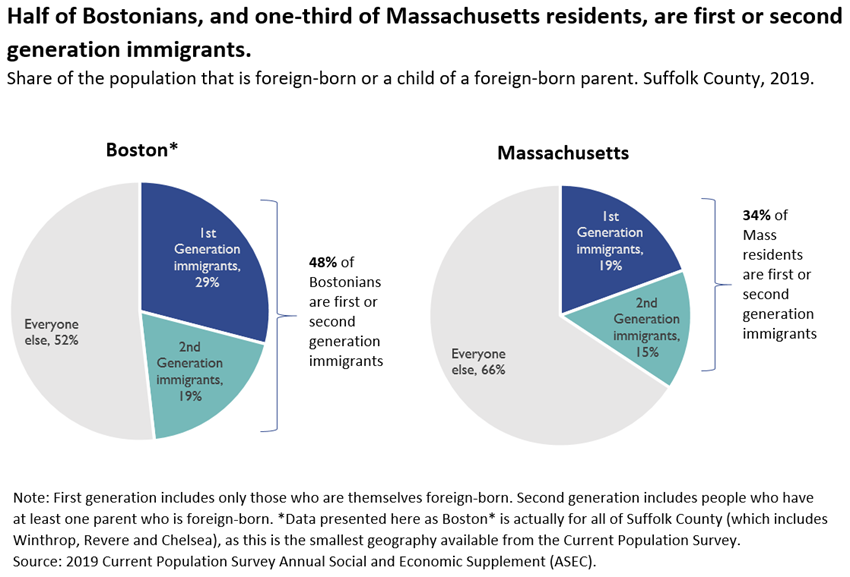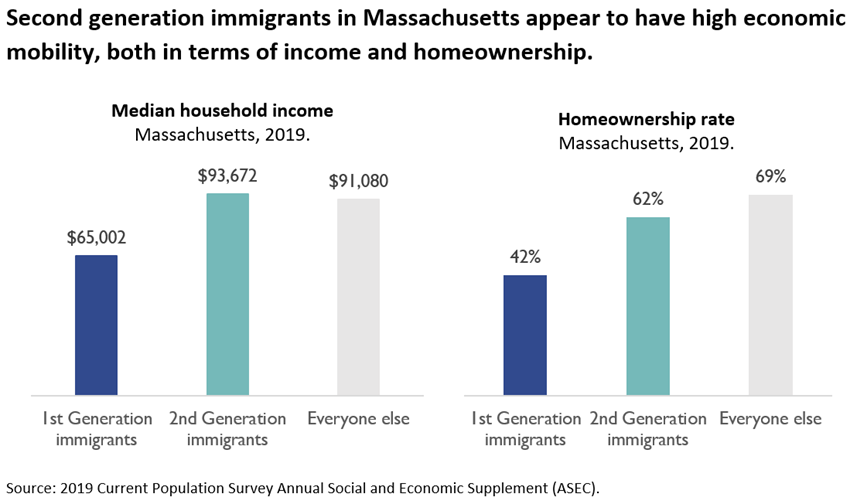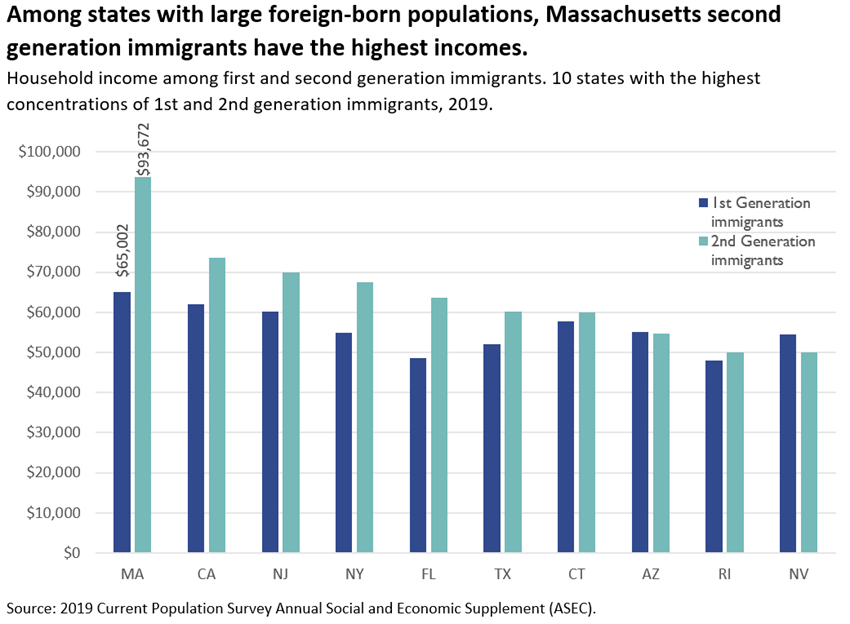Second generation immigrants in Massachusetts have among the highest incomes in the country
By Trevor Mattos
October 30, 2019
This is an online version of our Boston Research Snapshot email newsletter from October, 2019. Sign up to get the newsletter in your inbox every month.
According to a new NBER paper released this week, second generation immigrants are successfully climbing the economic ladder, with incomes that surpass those of their foreign-born parents, and sometimes even surpass the incomes of native-born Americans. In fact, it appears that recent waves of immigrants are even more economically mobile than prior ones.
Over the past year, Boston Indicators has done two major reports on immigration in our region: We detailed how a recent global wave of immigration has fueled our region’s economic resurgence; and we described what’s at stake for Massachusetts as the federal government increasingly restricts legal immigration to this country. This work has followed a common research approach, mostly using data on people born abroad to estimate conditions in the immigrant community. But as the NBER paper shows, immigrant dynamics play out in different ways across multiple generations. So in this piece we examine data on second generation immigrants here in Massachusetts—people who themselves were born in the U.S. but who have at least one foreign-born parent—to get a sense of how this generational story plays out locally. The data are striking. As you’ll see in the following graphs, roughly half of all Bostonians (and a third of Massachusetts residents) are first or second generation immigrants, and second generation immigrants appear to have high incomes and homeownership rates. Even though the parents of many of these second generation immigrants arrived to the U.S. with relatively fewer economic resources, the second generation now has socioeconomic characteristics similar to those of native-born residents of Massachusetts.
The fact that almost half of Bostonians and more than a third of Massachusetts residents are first- or second-generation immigrants is remarkable, but so too are their socioeconomic characteristics. A quick data note: Because the sample size of the Current Population Survey (CPS) data is somewhat limited, it was not possible to analyze economic characteristics at the city level, so from here on we focus on Massachusetts. When we do, we find that second generation immigrants have an estimated median household income 44 percent higher than that of first generation immigrants ($94,000/year compared to $65,000/year). Although it also looks like second generation immigrants have slightly higher incomes than everyone else, the difference between the two is not statistically significant.
The Census Bureau released a first-ever report with similar findings in 2013, showing that, nationally, second generation immigrants’ median household income was 13 percent higher than that of first generation immigrants (in the 2019 data the difference is 16 percent). While our local findings are consistent with this Census report, it’s striking that the second-generation income advantage here in Massachusetts is about three times larger than it is nationally. Many different factors affect the economic outcomes of second generation immigrants, but the Census Bureau specifically pointed to second generation immigrants’ having higher levels of educational attainment as a key driver. Given the Boston area’s comparative advantage in the knowledge economy and in delivering high quality education, it makes sense that second generation immigrants here could achieve even greater economic mobility than their counterparts in other regions. Second generation immigrants are more apt to live in households with multiple earners, so this likely explains a portion of the gap in incomes between the two generations of immigrants.
Second generation immigrants in Massachusetts also have homeownership rates that are 20 percentage points higher than that of first generation immigrants. People with two native-born parents (“everyone else”) have the highest homeownership rates, but it’s possible that if we controlled for different age distributions the gap between these two would close significantly—second generation immigrants tend to be younger than “everyone else.” At the national level, a 2017 study by Harvard’s Joint Center for Housing Studies found that after controlling for different age distributions, older second generation immigrants own homes at similar rates to native-born residents. (The JCHS analysis also revealed higher household incomes for second generation immigrants than for people with two native born parents, when controlling for age.)
We also compared first and second generation incomes in Massachusetts with those in the nine other U.S. states with the largest immigrant communities. We found that among second generation immigrants in all these states, those in Massachusetts have the highest incomes. Second generation immigrants in Massachusetts have estimated median household income that’s $20,000 higher than the runner up, California. This is based on 2019 data alone. Massachusetts also has the largest difference between first and second generation immigrants. While the estimates below do have considerable margins of error, the findings for Massachusetts are statistically significant. To be clear, the CPS data do not show how sharply second generation immigrants’ incomes differ from those of their own first-generation parents, so we can’t definitively estimate intergenerational economic mobility over time for immigrant families in Massachusetts with these data. Even still, the point-in-time data comparing first and second generation immigrants certainly do suggest that Massachusetts has high rates of intergenerational immigrant mobility compared to peer states.
This preliminary analysis helps support the idea that while immigrants nationwide have high rates of economic mobility, this may be especially true in Massachusetts. It’s worth noting again that this is the first time we’ve analyzed outcomes for second generation immigrants, and so we have some important lingering questions. If anyone has thoughts about this early research, we’d love to hear ’em, especially any reactions to these specific questions:
- How much might these better outcomes for immigrants and their families in Massachusetts be driven by specific local effects, like our K–12 schools, local public services, longstanding and emerging ethnic enclaves that provide social capital for new immigrants?
- How may these outcomes be driven by compositional effects? Could our second generation population have higher incomes in part because those living in Massachusetts are just different from those living in other states? For instance, maybe the foreign-born parents of second generation immigrants in Massachusetts came to the U.S. much earlier than the parents of second generation immigrants in other states.
- What related research might you recommend us exploring?



